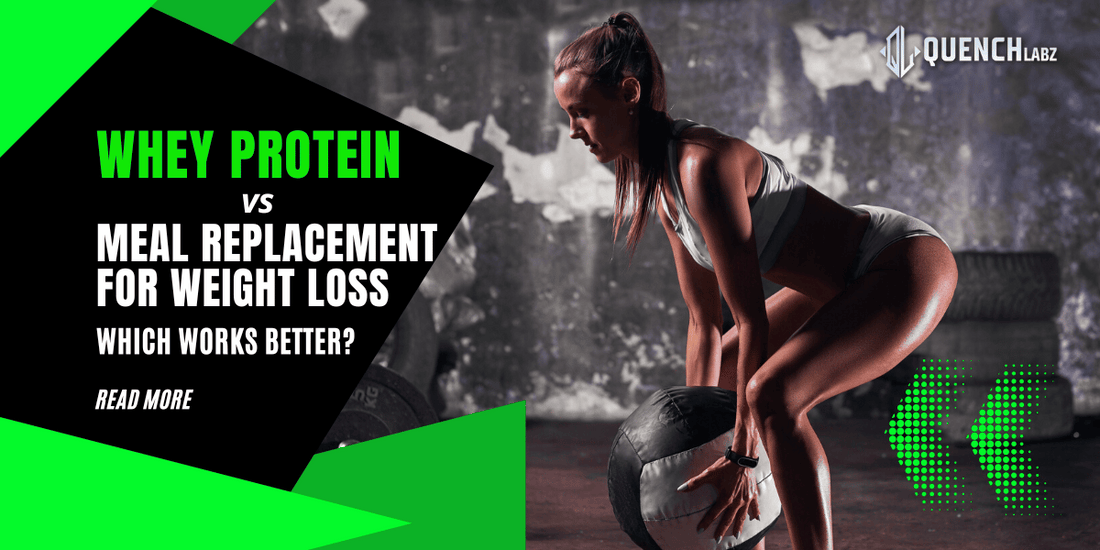When it comes to shedding those extra kilos, everyone seems to have an opinion. Low-carb, keto, intermittent fasting, detox juices — the list never ends. But in recent years, two nutrition tools have stood out for their simplicity and effectiveness: whey protein and meal replacement shakes.
Both are often marketed as quick and convenient solutions for weight loss. But are they the same? Do they serve the same purpose? And more importantly, which one actually works better for sustainable fat loss?
Let’s break it down.
What Is Whey Protein?
Whey protein is a high-quality protein derived from milk during the cheese-making process. It's rich in all nine essential amino acids, making it a complete protein. This matters because complete proteins are critical for muscle repair, recovery, and satiety.
For anyone on a fat-loss journey, whey protein is often used to:
-
Increase daily protein intake
-
Support muscle retention while in a calorie deficit
-
Improve recovery from workouts
-
Curb appetite naturally
Unlike meal replacements, whey protein isn’t a full meal. It lacks significant carbs, fats, and fiber. Think of it more as a supplement, not a substitute.
What Is a Meal Replacement Shake?
A meal replacement shake, as the name suggests, is designed to replace an entire meal. It usually contains a balance of:
-
Protein (often whey, soy, or pea protein)
-
Carbohydrates
-
Fats
-
Fiber
-
Essential vitamins and minerals
These shakes are engineered to be nutritionally complete, meaning they offer the calories and nutrients you'd get from a typical breakfast or lunch in a convenient drinkable format.
People trying to lose weight use meal replacement shakes to:
-
Control calorie intake
-
Avoid overeating or impulsive snacking
-
Get a balanced meal without the hassle of cooking
-
Stay full for longer hours
Whey Protein vs Meal Replacement: The Key Differences
| Feature | Whey Protein | Meal Replacement Shake |
|---|---|---|
| Purpose | Supplement protein intake | Replace full meals |
| Calories | Typically 100 to 150 kcal per serving | 200 to 400 kcal per serving |
| Macros | High protein, low fat and carbs | Balanced macros: protein, carbs, fats |
| Vitamins/Minerals | Minimal | Fortified with essential nutrients |
| Best Used For | Post-workout or between meals | As a low-calorie meal substitute |
| Satiety | Moderate | Higher due to fiber, fat, and volume |
Which Is Better for Weight Loss?
The answer isn’t one-size-fits-all. It depends on your lifestyle, goals, and eating habits. But let’s compare the benefits of both when it comes to real-world fat loss.
Why Whey Protein Works for Weight Loss
-
Preserves Lean Muscle Mass
During calorie restriction, you lose fat but also some muscle. Whey helps retain muscle mass, which keeps your metabolism higher. -
Boosts Satiety Between Meals
A scoop of whey with water or milk can keep hunger at bay for a couple of hours, preventing mindless snacking. -
Low in Calories, High in Protein
Ideal for those who already eat whole foods but want to increase protein without adding too many extra calories. -
Pairs Well with Workouts
If you exercise regularly, whey protein can speed up recovery and support better fat-to-muscle ratio improvements.
Why Meal Replacement Shakes Work for Weight Loss
-
Portion Control Made Easy
If your main struggle is portion size or high-calorie meals, replacements offer a controlled calorie intake. -
Convenient for Busy Schedules
No time to cook? A meal shake provides balanced nutrition in minutes, without the temptation of fast food. -
Keeps You Full Longer
Thanks to fiber, fats, and volume, a quality shake can keep you full for 3 to 4 hours, making calorie control easier. -
Reduces Decision Fatigue
Knowing what to eat is often half the battle. Replacing one meal daily with a shake simplifies your plan.
Real-Life Scenario: What Should You Use?
Use Whey Protein If:
-
You already eat 2 to 3 home-cooked meals daily
-
You want to supplement protein, not replace meals
-
You work out regularly and need post-workout nutrition
-
You need something light between meals to avoid cravings
Example:
You have lunch at 1 pm but feel hungry around 4:30 pm. A whey protein shake can bridge the gap without adding unnecessary calories.
Use Meal Replacement Shakes If:
-
You skip meals or eat junk when busy
-
You’re struggling with portion sizes and calorie tracking
-
You want a hassle-free, low-calorie meal
-
You prefer structure and fewer food decisions
Example:
You’re always rushing in the morning and end up skipping breakfast or grabbing a pastry. Replacing that with a meal shake can prevent hunger-driven bingeing later in the day.
Can You Combine Both?
Absolutely. Many successful fat-loss plans include both:
-
Meal replacement shake for breakfast or lunch
-
Whey protein post-workout or as a light evening snack
This combo helps cover your nutrition bases, ensures enough protein, and keeps hunger under control while supporting sustainable weight loss.
Final Verdict: It’s About the Bigger Picture
So, which works better: whey protein or meal replacement shakes?
If your diet is mostly in place and you want to preserve muscle and curb snacking, whey protein can be the perfect fat-loss companion.
If you’re constantly skipping meals or eating fast food out of convenience, meal replacement shakes can help simplify your journey.
But neither is magic on its own. What matters most is being in a calorie deficit, eating enough protein, staying consistent, and finding what works best for your routine.






